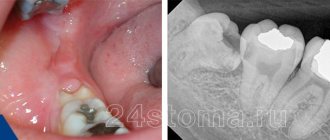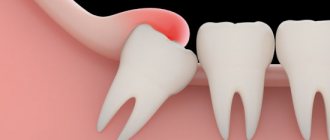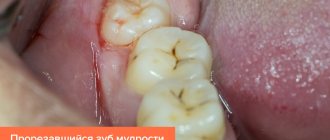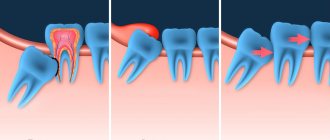For most people, the growth of wisdom teeth is accompanied not only by gum cutting and discomfort, but also by quite severe pain that makes it difficult to eat, concentrate on any task, and even sleep.
If the wisdom tooth grows and does not cause significant discomfort, no medical action may be taken. As a rule, the discomfort goes away after 1-2 weeks, but in order to avoid the manifestation of other problems, it is worth undergoing an examination at a dental clinic. However, if the gums from the wisdom tooth become inflamed, the local and general temperature rises, and specific aching pain is felt, immediately contact your dentist, he will conduct an examination and take the necessary measures to eliminate the problem.
How long does a wisdom tooth hurt as it grows?
If there is enough space for the “eight”, and the gum tissue is not particularly dense, the new tooth will grow quickly: in total, the suffering will last no more than 2 months. In this case, although the sensations will be unpleasant, they will be quite tolerable.
If the gums hurt very badly, swelling appears or the temperature rises, most likely there is an infection under the hood. This happens even with normal eruption of the third molar.
Does a wisdom tooth always hurt when it comes through?
When wisdom teeth erupt, 90% of people experience pain. And, probably, each of them is sincerely perplexed why, in childhood, teeth were replaced unnoticeably, without causing any discomfort. The answer is simple:
- firstly, in childhood, bone tissue is softer and more elastic;
- secondly, permanent teeth appear where baby teeth already existed.
But the “eights” have to literally win their right to life, cutting through the thickness of dense, healthy bone. It is for this reason that the upper wisdom teeth erupt less painfully - the bone of the upper jaw is less dense.
Dentists have long noticed that the later the “eights” begin to grow, the more pain they will cause to their owner. This is explained by the fact that the formation of human bone tissue is completed by the age of 25-27. And every year in her youth she becomes less and less pliable.
How long does a tooth hurt when there is a complication?
If the wisdom tooth does not grow in the required 60 days, something did not go according to plan. And in such cases, when talking about timing, dentists do not undertake to give any forecasts. Perhaps, with careful adherence to oral hygiene and constant monitoring by a doctor, the third molar will still grow in the near future.
But there is no less chance that the process will become chronic. Millions of people around the world experience excruciating exacerbations for years. The pain subsides for a while, but after a couple of months, and sometimes a couple of years, the tooth begins to cut again, and the pain returns with renewed vigor.
How long does it take to cut through a figure eight?
The duration of wisdom tooth growth is influenced by many factors. On average, it takes about 2-3 years from the appearance of the first signs to complete eruption. The speed at which a tooth is released from the gum depends on both the size of the jaw and its location in it. Vertical “eights”, if there is free space, fully grow in 1-2 years. Horizontal and slanted units on a small jaw may take 2-5 years to release. Considering that each of the 4 wisdom teeth can begin to grow at different times, the appearance of all of them can take up to 10 years.
Why does a wisdom tooth hurt as it grows?
There are only 5 causes of such pathological, often unbearable, pain.
- Not enough space in the dentition .
Wisdom teeth are rudiments; we inherited them from our ancestors, whose jaw was 10-12 centimeters wider. Now, many people simply do not have room in their teeth to fit another tooth. But the “extra” molar is growing. And even if the direction of growth is correct, the impostor puts pressure on the teeth in front, moves them to the center and, in the end, wins back its place. This process, which occurs in the thickness of the bone, is very unpleasant and painful. And it ends with unaesthetic crowding of teeth. - Wrong direction of growth .
It is impossible to predict how a wisdom tooth will grow. If you're lucky, it will become clearly vertical. But very often its axis is deviated to the side. And then, at best, the tooth will scratch the gums, tongue or palate. At worst, it will begin to push the roots of the “seven”, inevitably destroying it. Pain due to dystopia, which is what dentists call the pathological direction of growth of the “eight”, is impossible to withstand without strong painkillers. It shoots and crushes, cuts and stabs, hits the ear and temple, not allowing you to forget for a second about the culprit of the torment. - Development of bacterial infection .
When the teething process drags on for months, or even years, a so-called “hood” forms over the wisdom tooth. It is formed by the gum covering the molar. Food debris inevitably gets into this fold, and the inability to maintain proper care leads to inflammation - pericoronitis. Its main symptom is an increase in body temperature, which can reach 400 C. In this case, the patient complains of constant aching pain, the inability to talk, eat, and sometimes even open his mouth. Upon examination, swelling and redness of the gums are clearly visible. - Trigeminal neuralgia .
Perhaps the most vivid sensations of pain were experienced by those people whose wisdom tooth once touched one of the branches of the trigeminal nerve. They provide sensitivity to facial tissues, soft tissues of the mouth and teeth. And if a wisdom tooth presses on a nerve, unbearable pain begins, affecting not only the jaw, but also the throat, ear, and head. The patient cannot even understand what hurts more. - Caries, pulpitis, periodontitis .
Just like other teeth, the third molar can become diseased. More often this happens with an already erupted tooth. But sometimes an infection that gets under the hood affects not only the soft tissues, but also the wisdom tooth itself. And then the dentist will have to decide whether it is worth treating the disease, or whether it is easier to immediately remove the third molar.
Wisdom teeth removal with 20% discount
Moscow
Impacted third molars
- Lack of space leads to abnormal placement of the tooth in the jaw arch. Impacted teeth can grow towards the cheek and constantly injure its mucous membrane.
- In the absence of an antagonist in the opposite jaw, they cause serious malocclusion, ultimately leading to imbalance of the masticatory muscles, pinched nerve endings, dysfunction of the temporomandibular joint and even neurological disorder.
- A tooth that does not come out of the bone often provokes the formation of a follicular cyst, which does not manifest itself for a long time. This is explained by the presence of remnants of a follicle around it, the cells of which, for as yet unknown reasons, begin to multiply. The roots of the adjacent molar often get into the lumen of the cyst. This leads to necrosis of their pulp and necessitates the treatment of pulpitis and depulpation of the tooth.
- The third molar can put pressure on the roots of the second, causing headaches, soreness in the ear or throat.
In what cases is it better to remove a tooth?
Old school dentists insist that at the first discomfort of the patient, wisdom teeth should be removed without regret. Modern dentistry is more humane and is convinced of the need for strict indications for the procedure, rightly noting that in due time “eights” may become the only possible support for dentures.
Indications for removal are:
- eruption of the third molar outside the dentition;
- threat of displacement of adjacent teeth;
- abnormal position of the crown and pressure on the second molar;
- impossibility of therapeutic treatment of the tooth.
Today, at the first visit with complaints of pain caused by the “eight”, the dentist first takes an x-ray to examine the position of the roots, the shape of the tooth and its condition. And only then evaluates all the risks. With this approach, a wait-and-see tactic is increasingly being chosen: the doctor selects painkillers that will help survive the pain that is natural to the teething process. If necessary, incises the gum and cuts off the hood. And then for several months he observes how the wisdom tooth will behave.
Dentists of the Israeli school even fight for impacted wisdom teeth, pulling them out and putting them in the right place with the help of orthodontic instruments. The main thing is that there is enough space in the patient's jaw.
Is it painful to have a wisdom tooth removed?
26% of operations to remove “eights” are no different from the removal of other molars. The wisdom tooth is simply pulled out using hand forceps after local anesthesia is administered. In this case, the patient, as a rule, does not even have time to get scared, the whole procedure goes so quickly.
Another thing is difficult removal. This operation can last up to 40 minutes, during which the surgeon saws the tooth with a drill and takes it out in parts. Unfortunately, this is the only way to remove a tooth that lies horizontally, or has frozen in its development, and has not erupted, but due to its location causes constant pain.
And even in this case, modern anesthesia can completely relieve pain. The same applies to the recovery period. First, in most cases, the surgeon will stitch up the resulting wound, speeding up the healing process. Secondly, he will prescribe painkillers for the coming days. Therefore, you should not be afraid of removal - it will cause much less pain than regular exacerbations.
Consumer Reviews
Endge1305 (irecommend.ru)
“As I already wrote in my other reviews of means to fight for my favorite teeth, I have periodontal disease. And for some reason it is very aggressive, outdated, neglected. I don’t know why this bug has clung to me, but I’ve been suffering from it for a long time.
When I was young, it didn’t bother me at all, but two pregnancies and two breastfeedings meant that I lost a couple of teeth. Perhaps this would not have happened if my gums were in order.
And there was a threat that I would say goodbye to many more teeth, since the lower row of teeth acquired tartar, and the upper incisors were suspiciously very loose.
Attention! If your teeth have just started to become loose, take it seriously and see a periodontist. Fortunately, we still have free medicine and this service is also provided. It was there that the doctor prescribed me the Asepta Anti-inflammatory Gel for the treatment of periodontal disease.
It contains propolis, which is known to be a powerful anti-inflammatory natural antibiotic. My dad is a beekeeper, and I am closely acquainted with him (bee cud). I chewed it before, I liked its bactericidal effect. Sore throat, pain disappears. But propolis looks terrible on teeth. One day I went for a medical examination. It turned out that it was necessary to see a dentist there.
How ashamed I was to go to him, because not long before I had chewed propolis! My teeth were covered in this yellow gum that stuck like glue and couldn’t be removed at all! The specialist was quite surprised, but praised him for chewing propolis.
I knew that it helps against periodontal disease. But now I can’t chew - propolis apparently greatly increases immunity. Therefore, arthritis reacts to it and the joints become inflamed. This only applies to those people who have autoimmune disease.
If you prefer a civilized approach to dental treatment, you don’t need to chew anything like that, because the industry has already produced a medicinal gel based on propolis, which I’m writing about. Only the packaging is very small and there is a tiny amount of gel, namely 10 grams. They could have at least made a 50 gram tube.
But the manufacturer turned out to be too economical. Just imagine that the Doctor prescribed a periodontal treatment plan for me for 2 weeks. In this case, the product had to be applied to the gums at least 2 times a day. Of course, this quantity was not enough. I had to buy more packaging.
But many will not buy - most likely they will forget or regret the money. In general, I think that this is not convenient.
Anyway. It's on their conscience. The tube is sealed, I had to poke a hole in it with a needle. Inside there is a light yellow ointment that smells like bee products.
I did the procedures in the morning and evening as prescribed. I squeezed the gel onto my finger and applied it to my gums. I waited ten minutes.
It was just boring and unpleasant to wait, since it was impossible to swallow saliva. Again, propolis is harmful to me, and secondly, the product is not for oral use. The saliva accumulated and I had to endure it. You know this feeling yourself, right? And you can’t spit it out, because you’ll spit everything out from your gums, and swallowing it is also forbidden. Overall, it was fun. I don't think I lasted 10 minutes. I'll tell you straight, obviously not 10)
I don’t know, maybe some kind of cotton swabs should have been used to solve this problem. But I preferred to throw my head back and look at the ceiling in the bathroom, because you can’t really walk around the apartment with your mouth open...
..In general, the sensations from using the gel were pleasant. It is refreshing, there is a feeling that it is healing the gums. Next time I will look for a larger tube so that I always have a reserve and use it for prevention.”
katyushka237 (otzovik.com)
“The choice of drugs for oral diseases is not very wide. And, for the most part, they all contain two antimicrobial components: metronidazole and chlorhexidine. There may come a time when they stop working, due to microorganisms developing resistance to them.
This situation arose for me after undergoing gum surgery some time ago. The recovery period was quite long and I had to shorten it with the help of antimicrobial gels, which lost their effectiveness over time.
Therefore, quite recently, when a slight stomatitis appeared, I remembered the Asepta gel, which my doctor prescribed to me a long time ago and which I was not able to try at that time. The gel is available in two forms: with the above-mentioned metronidazole and with propolis. The second option turned out to be the most suitable for me and, accordingly, effective due to the presence of a natural antimicrobial component in the composition.
The gel is available in an aluminum tube and comes with an applicator. It is useless, since it cannot be used to apply the gel normally and a large amount of it is consumed. When applied, the taste of propolis is felt, in general, the taste is normal and disappears after about half an hour. The main thing, of course, is not this, but the effectiveness, which, compared to the above, is high if you carry out a course of treatment and do not give it up immediately after the symptoms disappear.”
How to relieve pain?
At the first unpleasant sensations from a growing wisdom tooth, frequent rinsing with Chlorhexidine, Miramistin or Eludril solution helps. If you can’t run to the pharmacy, you can prepare a soda-salt solution: dissolve 1 teaspoon of soda and salt in one glass of warm boiled water.
Supporters of traditional methods can use oak bark, sage and chamomile. To do this, you need to take 3-4 tablespoons of the mixture, composed in equal proportions, and pour 500 ml of boiling water. Leave for an hour and strain before using.
Rinses are effective only if the pain is caused by the natural process of tooth eruption. All of the listed drugs, both pharmaceutical and home-made, relieve swelling well and suppress the activity of pathogenic microflora in the oral cavity.
If symptoms of an attached infection have already developed: fever, swelling, severe swelling, surgical intervention will most likely be required: removal of either the hood or the tooth itself. In order to reduce the risk of complications, the doctor will definitely prescribe antibiotics.
Please note: it is strictly forbidden to prescribe antibiotics to yourself!
But painkillers should be taken before visiting the doctor. In this case, the following are effective:
- Broad spectrum analgesics
. Analgin, Ketanov, Paracetamol relieve pain for several hours, usually from 1 to 5. It is also possible that the tablet will not work at all. You can increase the dose, the main thing is to strictly follow the instructions. - Anti-inflammatory drugs.
Nurofen, Ibuprofen, Diclofenac can not only provide a powerful analgesic effect, but also relieve fever and reduce swelling. - Ointments, gels, sprays for topical use
. Holisal, Metrogyl Denta, Kamistad, Angilex “freeze” any sensations in the sore gum for 2-3 hours.
An ordinary piece of ice relieves pain well. It needs to be wrapped in a cloth and applied to the external projection of the diseased tooth on the cheek. Hold for no more than 5-7 minutes. Do not put ice directly on the gum. Its tissues are too delicate and direct contact can lead to necrosis.
The most original folk method of getting rid of toothache when a wisdom tooth comes out: take a plantain leaf, wash it and roll it into a tube. Then you need to insert the sheet into the auricle, but always on the side on which the tooth hurts. Dentists call such methods useless. But this method does not cause any harm. So why not try?!











